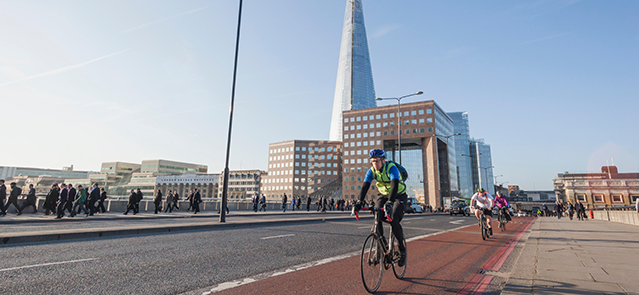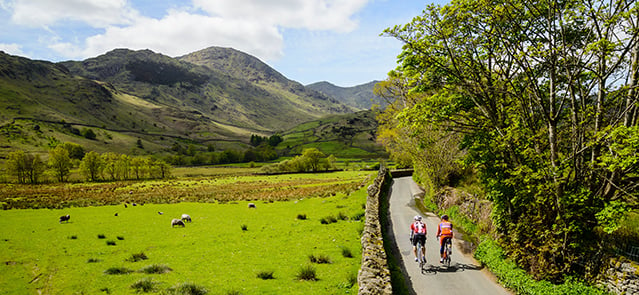How to cycle on the roads with confidence
June 13, 2016
Don’t let fear undermine your experience of taking to the open road. Cycle specialist Richard Peace explains how practice, planning and the right kit are key to the perfect ride

Photograph: Alamy
Are the UK’s roads really safe for cycling? You might not think so when you’re on a city street in the rush hour, or being overtaken by a lorry on a countryside lane. In fact, 67% of non-cyclists in Britain feel that it is too dangerous to ride on the roads, according to government data.
But there are now more high-quality cycle lanes and trails than ever before where you can ride in safety. And even if you’re mixing with motorised traffic, the health benefits of taking to your bike mean you’re still better off pedalling than sitting on the sofa.
Campaigning charity Cycling UK says the health advantages of cycling outweigh the injury risks by between 13:1 and 415:1, according to various studies. The charity also says that people who cycle regularly in mid-adulthood typically enjoy a level of fitness equivalent to someone 10 years younger, and have a life expectancy two years above average.
Riding with confidence
Once you’ve decided to take the two wheel challenge, how do you go about feeling safe on the road? Why not try a government-certified Bikeability course? It’s like a rebranded and improved Cycling Proficiency Test, for those old enough to remember. Simply turn up with your bike for practical instruction in a choice of three levels.
The first level teaches basic control skills in a traffic-free environment; the second trains you to use minor roads; and the third equips you to cope with busier roads and advanced road layouts. Courses are held in a wide variety of venues, such as schools and workplaces.
If you’d prefer to learn off the page, Cyclecraft by John Franklin is widely regarded as the definitive book on road cycling advice (though you may learn the basics more quickly and easily on a good Bikeability-type course). City Cycling by Richard Ballantine is a great alternative if you want good road sense tips mixed in with general advice for less experienced cyclists.
Equipped for the road
When it comes to what you should wear on the road, you might think a helmet is a helmet. However, cheaper options may actually be dangerous, as well as being uncomfortable and ill-fitting. The first rule is that they must have a CE EN 1078 sticker to show they have passed a number of basic construction tests.
Premium helmets often have ‘a retention system’ – a padded plastic cage construction within the helmet itself – which gives a tight fit. Some designs allow this cage to be adjusted with a rotating button at the rear of the helmet. As well as the retention system look out for:
- sufficient padding
- comfortable and easily adjustable chinstrap
- plenty of ventilation
Reputable makes include Btwin (Decathlon), Uvex and Specialized.
When it comes to illuminating unlit or poorly lit roads and paths, there is a great array of powerful LED lights out there. My own favourites are Knog Blinders. These can be removed in a trice and have a USB connection on the light itself for recharging, so you don’t need to carry a separate charger.
Meanwhile, Lightrider lights are innovative and useful; these both have a front-facing and rear-facing light, the rear-facing one actually lighting up the rider and making them more visible.
But for the ultimate in low-maintenance lighting, get a bike with a hub dynamo that provides power that will never run out. If you don’t fancy the extra weight of a hub dynamo you might want to invest in the remarkable and tiny rim dynamo from Velogical in Germany.
Finally there is ‘wearable tech’, which combines high-vis and reflective jackets with LED lights. Although still in their infancy as larger firms perfect the technology, market-leading Visijax has some good products.
Getting out there
Enough of the preparation – what about the best places to get out cycling and enjoy yourself? There are now several hundred traffic-free trails across the country, which are wonderful for both leisure riding and improving your cycle skills.
Cycling charity Sustrans has a great online map covering bike routes across the whole of the UK and it’s worth investigating whether your local council has maps showing more routes. There are also plenty of quiet cycle lanes and minor road routes out there too, you just have to look.
In London, there are the Cycle Superhighways, put in place by former London Mayor Boris Johnson and welcomed by the London Cycling Campaign. With Johnson credited for starting to introduce extremely safe Dutch-style design standards for many bike lanes, northern cities are following his lead and a multimillion-pound superhighway linking Leeds and Bradford is due to open this month (June 2016).
There are plenty of quiet cycle lanes and minor road routes out there. Photograph: Alamy
Go your own way
You don’t have to follow someone else’s route. There are thousands of miles of little-used country lanes, so with careful planning and exploration you may find a virtually traffic-free or at least quiet route where you will feel very safe while taking in glorious surroundings.
However, don’t always assume the little yellow road on the map is a quiet byway – it may be a scary rat run. Again, research and exploratory ride planning pay dividends in seeking out safe and enjoyable routes.
For those considering a bicycle commute through the city, the idea of sharing the road with a sea of cyclists may seem off-putting. However, in 2009, Cycling UK compiled evidence from more than 100 English local authorities that suggests it is less risky to ride in places where there are higher levels of cycle commuting.
Cyclist numbers have boomed in the capital over recent years and Transport for London has campaigned publicly to educate drivers and cyclists. Other popular UK cycling cities include Cambridge, Oxford and York.
So don’t be put off if you aren’t an experienced cycling veteran; with a bit of practice, route planning and the right gear you might just be surprised by how enjoyable cycling can be.
Six simple steps for the born-again cyclist
David Dansky, head of training and development at Cycle Training UK, gives his tips for newly converted cyclists:
- make sure your bike is comfortable to ride and roadworthy
- practise your bike control in a secure traffic-free area
- once this is instinctive, practise sharing the highway on quiet roads
- make sure you position yourself in the road away from the kerb, where you can be seen
- make sure you communicate your intentions clearly to other road users
- be aware of all other road users, looking behind you regularly
Richard Peace is a regular contributor to Cyclists Touring Club magazine and Cycle magazine
Find out more about Hiscox bicycle Insurance







 Very satisfied with the service from Hiscox as always
Very satisfied with the service from Hiscox as always

